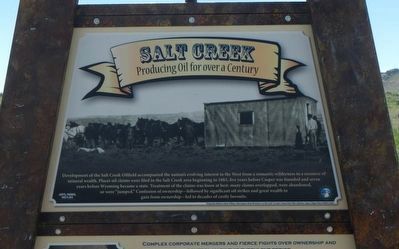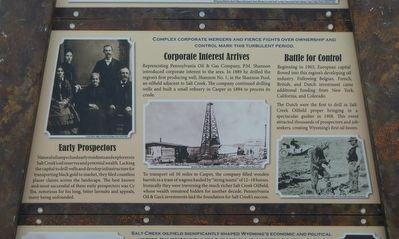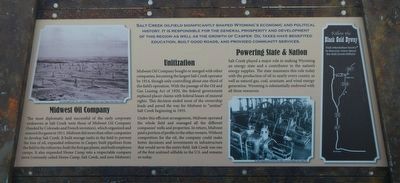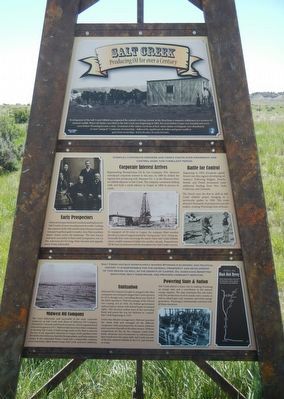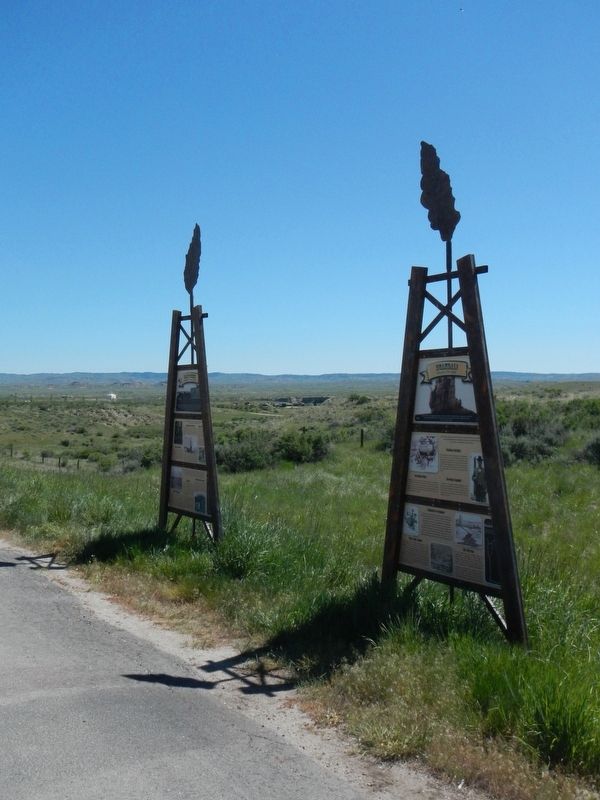Near Midwest in Natrona County, Wyoming — The American West (Mountains)
Salt Creek Oil Field
Producing Oil for over a Century
Inscription.
( top panel:)
Development of the Salt Creek Oilfield accompanied the nation’s evolving interest in the West from a romantic wilderness to a resource of mineral wealth. Placer oil claims were filed in the Salt Creek area beginning in 1883, five years before Casper was founded and seven years before Wyoming became a state. Treatment of the claims was loose at best: many claims overlapped, were abandoned, or were “jumped.” Confusion of ownership – followed by significant oil strikes and great wealth to gain from ownership – led to decades of costly lawsuits.
(middle panel:)
Early Prospectors
Natural oil seeps clued early residents and explorers to Salt Creek’s oil reserves and potential wealth. Lacking the capitol to drill wells and develop infrastructure for transporting black gold to market, they filed countless placer claims across the landscape. The best known and most successful of these early prospectors was Cy Iba, notorious for his long, bitter lawsuits and appeals, many being unfounded.
Representing Pennsylvania Oil & Gas Company, P.M. Shannon introduced corporate interest to the area. In 1889 he drilled the region’s first producing well, Shannon No. 1, in the Shannon Pool, an oilfield adjacent to Salt Creek. The company continued drilling wells and built a small refinery in Casper in 1894 to process its crude. To transport oil 50 miles to Casper, the company filled wooden barrels in a train of wagons hauled by “string teams” of 12-18 horses. Ironically they were traversing the much richer Salt Creek Oilfield, whose wealth remained hidden for another decade. Pennsylvania Oil & Gas’s investments laid the foundation for Salt Creek’s success.
Beginning in 1903, European capital flowed into the region’s developing oil industry. Following Belgian, French, British, and Dutch investment came additional funding from New York, California, and Colorado.
The Dutch were the first to drill in Salt Creek Oilfield proper brining in a spectacular gusher in 1908. This event attracted thousands of prospectors and job seekers, creating Wyoming’s first oil boom.
(bottom panel:)
Salt Creek oilfield significantly shaped Wyoming’s economic and political history. It is responsible for the general prosperity and development of this region as well as the growth of Casper. Oil taxes have benefited education, built good roads, and provided community services.
The most diplomatic and successful of the early corporate endeavors at Salt Creek were those of Midwest Oil Company (funded by Colorado and French investors), which organized and entered the game in 1911. Midwest did more than other companies to develop Salt Creek. It built storage tanks in the field to prevent the loss of oil, expanded refineries in Casper, built pipelines from the field to the refineries, built the first gas plants, and built employee camps. It also expanded Home Camp into a respectable company town (variously called Home Camp, Salt Creek and now Midwest).
Midwest Oil Company bought or merged with other companies, becoming the largest Salt Creek operator by 1914, though only controlling about one-third of the field’s operation. With the passage of the Oil and Gas Leasing Act of 1920, the federal government replaced placer claims with federal leases of mineral rights. This decision ended most of the ownership feuds and paved the way for Midwest to “unitize” Salt Creek beginning in 1935. Under this efficient arrangement, Midwest operated the whole field and managed all the different companies’ wells and properties. In return, Midwest paid a portion of profits to the other owners. Without competition for the oil, the company could make better
decisions and investments in infrastructure that would serve the entire field. Salt Creek was one of the first unitized oilfields in the U.S. and remains so today.
Salt Creek played a major role in making Wyoming an energy state and a contributor to the nation’s energy supplies. The state maintains this role today with the production of oil in nearly every county, as well as natural gas, coal, uranium, and wind-energy generation. Wyoming is substantially endowed with all these resources.
Erected by Wyoming State Parks and Cultural Resources.
Topics. This historical marker is listed in these topic lists: Industry & Commerce • Natural Resources. A significant historical year for this entry is 1883.
Location. 43° 18.816′ N, 106° 15.33′ W. Marker is near Midwest, Wyoming, in Natrona County. Marker is on State Highway 256 near State Highway 387, on the left when traveling south. Touch for map. Marker is in this post office area: Midwest WY 82643, United States of America. Touch for directions.
Other nearby markers. At least 8 other markers are within 7 miles of this marker, measured as the crow flies. Scandal! (a few steps from this marker); a different marker also named Salt Creek Oil Field (approx. 6.7 miles away); Gushers, (approx. 6.7 miles away); Oil Boom Towns (approx. 7 miles away); Society in an Oil Patch (approx. 7 miles away); a different marker also named Salt Creek Oil Field (approx. 7 miles away); Midwest Veterans Memorial (approx. 7 miles away); Geology (approx. 7.1 miles away). Touch for a list and map of all markers in Midwest.
More about this marker. This marker is approximately 6 miles south of Midwest. It is part of the Black Gold Byway marker series.
Also see . . . First Wyoming Oil Wells - American Gas and Oil Historical Society. Tales of the “Great Tar Spring” would lead to Wyoming’s earliest hand-dug oil wells during the Civil War. “The first recorded oil sale in Wyoming occurred along the Oregon Trail when, in 1863, enterprising entrepreneurs sold oil as a lubricant to wagon-train travelers” explains Wyohistory.org. “The oil came from Oil Mountain Springs some 20 miles west of present-day Casper.” (Submitted on July 5, 2016, by Barry Swackhamer of Brentwood, California.)
Credits. This page was last revised on July 6, 2016. It was originally submitted on July 5, 2016, by Barry Swackhamer of Brentwood, California. This page has been viewed 413 times since then and 25 times this year. Photos: 1, 2, 3, 4, 5. submitted on July 5, 2016, by Barry Swackhamer of Brentwood, California.
